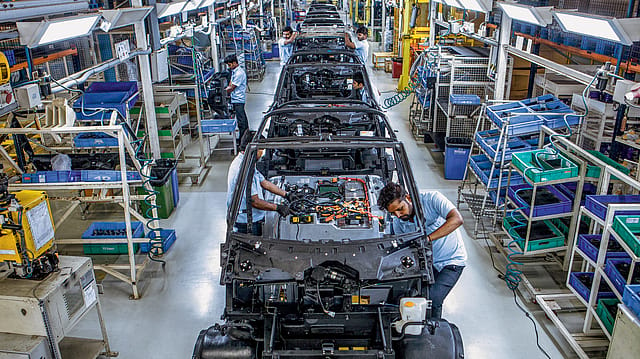U.S. tariffs force Indian firms to pivot: How hiring strategies are getting a radical reboot
ADVERTISEMENT

As the United States intensifies its trade posture with new tariff structures aimed at reshaping global supply chains, Indian-founded businesses with a significant U.S. presence are entering a phase of ‘recalibration’. The evolving nature of U.S. tariffs—especially on goods from key export sectors—has forced many to revisit operational strategies, workforce models, and geographic hiring decisions.
Across sectors, a cautious tone has set in, although it may be too early for sweeping conclusions.
“In the manufacturing sector, there has been an impact on input costs and hence new hirings or even replacement [hires] have gone on hold,” says Sunil Chemmankotil, country manager at Adecco India. “This is a lever most companies use when operational costs have to be maintained or brought down.”
What’s emerging isn’t necessarily a sharp pullback in hiring—but a pivot to more agile strategies. Contractual staffing, for instance, is becoming a preferred choice for many companies trying to stay nimble in uncertain times. “Contractual staffing is gaining prominence, especially in industries like manufacturing, where demand is cyclical and susceptible to trade policy changes,” observes Aditya Narayan Mishra, MD and CEO of CIEL HR.
December 2025
The annual Fortune 500 India list, the definitive compendium of corporate performance, is out. This year, the cumulative revenue of the Fortune 500 India companies has breached $2 trillion for the first time. Plus, find out which are the Best B-schools in India.
The tech sector—though not directly impacted by tariffs on goods—is feeling the downstream effects. Indian IT firms and system integrators serving sectors like retail, BFSI, and auto manufacturing are experiencing delays in decision-making and hesitancy in new tech rollouts, causing a slowdown in full-time hiring. “Apart from the slowdown at their end customers, the impact of AI is also profound,” says Chemmankotil. “System integrators are re-jigging their business model to non-linear growth… not dependent on people.”
But the response isn’t uniform. Startups and Global Capability Centres (GCCs) continue to hire steadily, albeit more selectively. “We’re observing a clear shift—not necessarily a complete slowdown, but a smart recalibration,” says Amritanshu Anand, co-founder of Recruiterflow. “Instead of large-scale recruitment drives, many Indian-founded businesses are doubling down on upskilling their existing teams and selectively hiring for high-impact roles, especially in AI and automation.”
Shift in Hiring Models
This recalibration is being matched by a larger rethinking of where talent is sourced. While India remains a dominant hub due to its talent depth and cost advantage, other geographies are entering the equation. “There’s growing interest in nearshore geographies like Latin America and Eastern Europe,” Anand shares. “What’s interesting is that this shift is not just about cost—it’s also about de-risking from over-reliance on a single geography.”
Some firms are even pushing work closer to home. “Companies are establishing GCCs in India to take advantage of availability of qualified talent, the business-friendly environment and competitive costs of running a GCC in place of operations in a western economy,” says Mishra.
Remote hiring, which gained momentum post-pandemic, is now being reinforced by tariff-driven uncertainties. “Many companies that previously insisted on U.S.-based teams are now fully open to hybrid and fully remote structures,” says Anand. “We’ve seen a 20–25% increase in job postings from U.S. clients that are open to remote-anywhere roles in the last quarter alone.”
With cost pressures rising, businesses are also redesigning roles and rethinking hiring models. “Companies are breaking down roles more granularly, sometimes splitting one full-time role into two part-time or contract-based ones,” Anand adds. “There’s a greater emphasis on outcome-based hiring, where the focus is on deliverables rather than hours or presence.”
This restructuring of hiring models is also being shaped by evolving trade policy expectations. Viswanath PS, MD & CEO of Randstad India, notes that tariff shifts are increasingly being used as strategic levers in trade negotiations, which means businesses need to be proactive in their responses. “While some sectors such as electronics and manufacturing may experience short-term challenges due to increased import duties, there is a notable trend towards strategic adaptation and resilience.”
Indeed, some Indian manufacturers are using this moment to localise operations, aided by government schemes such as the Production-Linked Incentive (PLI) programme. “Indian electronics manufacturers are leveraging the PLI scheme to boost domestic production and reduce dependency on imports,” says Viswanath. The PLI scheme has attracted over $17 billion in investments, resulting in production worth multiple trillions and close to 10-12 lakh jobs in the last five years. But with the scheme concluding in 2026, companies are also mindful of the need for longer-term, cost-effective solutions.
At the strategic level, hiring budgets are not just being cut—they’re being recalibrated to prioritise flexibility. “Recruitment strategies are becoming more data-driven and demand-sensitive,” says Mishra. “Instead of large-scale hiring, companies will opt for just-in-time recruitment, leveraging talent marketplaces, and tapping into gig platforms to maintain workforce elasticity without long-term payroll commitments.”
This flexibility-first approach extends even to leadership hiring. Fractional roles and project-based contracts are gaining popularity, especially in sectors where demand patterns remain volatile. “Indian-founded startups and mid-sized firms in the U.S. are especially mindful of burn rates and operational agility, and that’s reflected directly in the way they’re planning their hiring roadmaps for the next 2–3 quarters,” says Anand.
Still, there’s an overall agreement that this is not a long-term pullback but a 'momentary pause'. “Talent is essential for growth despite AI disruption and tariff pressures,” says Chemmankotil. “The workforce strategies might go through a revamp but hiring will continue—maybe at a reduced volume.”
Ultimately, the broader message is clear: Indian-founded businesses in the U.S. are not retreating—they’re adjusting.
